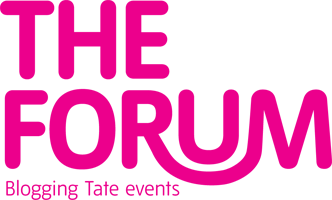At about a quarter past 11 on a slightly overcast Saturday morning, a white truck materialises outside Tate Modern's River Entrance. From the back of the truck, a bright orange forklift begins unloading several wooden palettes laden with rather large blocks of ice. The palettes are deposed at the four corners of an ad-hoc performance space demarcated by the sort of aluminium barricading one might find at an outdoor concert, protest rally, or parade. Onlookers have already begun to gather in anticipation of an event, some even pacing in front of the barricades like parents anxiously awaiting the dismissal of their children from primary school, right before the bell rings.
 All photography courtesy Sophia Spring
All photography courtesy Sophia Spring
In 1967, Allan Kaprow coordinated Fluids as a participatory activity or "happening," to be staged at locations throughout the southern Californian suburb of Pasadena with the aid of the general public and students taught by him at California Institute of the Arts (CalArts). Kaprow initially conceived Fluids as a work consisting of several "rectangular enclosures of ice blocks (measuring about 30 feet long, 10 wide and 8 high) ... built throughout the city. Their walls are unbroken. They are left to melt." In 2008, both Fluids and Scales (a similar activity from 1971 in which cinder blocks were hauled up and down the stairwells of the CalArts building by students, one block placed at each step as they ascended) were reinvented for free public view under the auspices of Tate curator Alice Koegel in collaboration with performing art students from Goldsmiths, University of London.
Kaprow also produced small, illustrated procedural manuals outlining instructions for the execution of oddly clinical and rather intimate activities typically engaging partners or groups of partners in close physical and potentially emotive contact. Manuals such as Comfort Zones (1975) were displayed under vitrines in the Turbine Hall over the weekend, accompanied by monitors showing documentation of the original Fluids and Scales activities transferred to DVD. These taken together -- along with an over sized red shoebox containing instructions for subsequent permutations of Fluids written by Kaprow in 2004 -- provided a compelling context from which to consider the events coming to life both within and without Tate Modern that day.
Surprisingly, it was in the details of these activitites that the differences between the 1967 context and those of 2008 began to emerge. One eco-conscious spectator standing next to me offered, "How many glasses of drinking water do you think that is? And how much energy did it take to make it into ice?" With melting polar icecaps and armed conflicts over access to precious potable water marking today's headlines, I suppose Kaprow's work unwittingly triggered political resonance for some viewers (or maybe just in the mind of the guy standing next to me).
I, for one, enjoyed the protective orange mitts and matching hazard-yellow safe ty vests sported by Goldsmiths students participating in both activities (protective gear of any kind was noticeably absent from the original footage from '67 and '71). I'm guessing that this later point owes much to London's notoriously restrictive Health & Safety measures, as does the fact that this time around the blocks of ice were stacked to a height of approximately five feet only instead of the full eight suggested by Kaprow's original specifications.
ty vests sported by Goldsmiths students participating in both activities (protective gear of any kind was noticeably absent from the original footage from '67 and '71). I'm guessing that this later point owes much to London's notoriously restrictive Health & Safety measures, as does the fact that this time around the blocks of ice were stacked to a height of approximately five feet only instead of the full eight suggested by Kaprow's original specifications. Such details aside, one striking continuity between the original documentation of Kaprow's work and Tate Modern's reinventions could be registered in the body language and general attitude of both participants and viewers on that day. I had long imagined early conceptual and performance art of the period as highly austere affairs, black-clad and mostly silent. From the original footage of Fluids and Scales however one gets the impression more of an outdoor barbecue than an historical "happening" or significant art event. Students in the films crack jokes and poke-fun at one other; sometimes spacing-out and appearing unsure as to what's supposed to happen next. Likewise, as the initial logistics of the building begin to work themselves out, the participants at Tate Modern's reinvention gradually relaxed and began striking up conversation with people on the other side of the barricades; tea was had and cigarette breaks taken, an occasional block of ice was dropped. One tourist yells into his mobile phone: "I'm outside by the ice thing, where are you?" and another onlooker responds to her companion's exasperated look with: "I just want to see if they all do something special at the end." A finale?
What came to life quite literally during the reinventions of Fluids and Scales was Kaprow's ability as an orchestrator of rather mundane human behavior, and his interest in revealing the potential for encounters with the poetic realm which lays dormant therein.
read more










